Future Dictates of Fashion
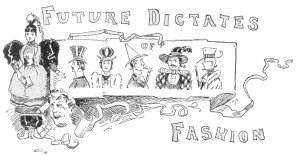

AN elderly gentleman of our acquaintance, whose reading has been rather desultory than profound, and tending rather to the quaint and speculative, was astonished recently at coming across a volume in his library of whose very existence he had been completely unaware. This volume was oblong in shape, was bound in mauve morocco, and was called "Past Dictates of Fashion; by Cromwell Q. Snyder, Vestamentorum Doctor."
Glancing his eye downwards past a somewhat flippant sub-title, the elderly gentleman came, with intense amazement, to understand that the date of this singular performance was 1993. Other persons at a similar juncture would have pinched themselves to see if they were awake, or have tossed the book into the street as an uncanny thing. But our elderly gentleman being of an inquisitive and acquisitive turn of mind, despite his quaintness, recognised the fact that if he was not of the twentieth century the volume obviously was; seized pen and paper, and began to make notes with the speed of lightning. Being also something of a draughtsman he was able to embellish his notes with sketches from the engravings with which "Past Dictates of Fashion" was copiously furnished. These sketches appear with the present article.
Fashion in dress, according to the twentieth century author, notwithstanding its apparent caprice, has always been governed by immutable laws. But these laws were not recognised in the benighted epoch in which we happen to live at present. On the contrary, Fashion is thought a whim, a sort of shuttlecock for the weak-minded of both sexes to make rise and fall, bound and rebound with the battledore called -- social influence. But it will interest a great many people to learn that Fashion assumed the dignity of a science in 1940. Ten years later it was taken up by the University of Dublin. By the science as taught by the various Universities later on were explained those points in the history, manners, and literature of our own ancestors which were formerly obscure and, in fact, unknown. They were also, by certain strict rules, enabled to foretell the attire of posterity. Here is a curious passage from the introductory chapter to the book:-
"Cigars went out of fashion twenty years ago. Men and yeomen consumed so much tobacco that their healths were endangered. The laws of Nature were powerless to cope with the evil. Not so the laws of Fashion, which at once abated it. It will, however, return in thirty-one years. In 1790 Nature commanded men to bathe. They laughed at Nature. In 1810 Fashion did the same thing. Men complied, and daily cold baths became established. In 1900 it was pushed to extremes. The ultra-sect cut holes in the ice and plunged into the water. The fashion changed. For forty years only cads bathed."
The following table is also interesting, and should be borne in mind in considering the accompanying cuts. It professes to exhibit the sartorial characteristics of an epoch :
TABLE OF WAVES.
Type Tendency.
1790 to 1815 ... Angustorial ... Wobbling
1815 " 1840 ... Severe ... Recuperative
1840 " 1875 ... Latorial ... Decided
1875 " 1890 ... Tailor-made ... Opaque
1890 " 1915 ... Ebullient ... Bizarre
1915 " 1940 ... Hysterical ... Angustorial
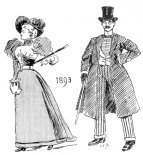 The first plate in the book is dated 1893, and serves as a frontispiece. The costumes of the lady and gentleman
are familiar enough, although we note with surprise that the gentleman's coat-tails seem to have a crinoline cast,
and if the turned-up bottoms of his trousers are a little mortifying, it is atoned for by a triumphant attitude which
disarms hypercriticism. Also the lady's posture makes it difficult for us to tell whether it is a stick or an umbrella she
is carrying.
The first plate in the book is dated 1893, and serves as a frontispiece. The costumes of the lady and gentleman
are familiar enough, although we note with surprise that the gentleman's coat-tails seem to have a crinoline cast,
and if the turned-up bottoms of his trousers are a little mortifying, it is atoned for by a triumphant attitude which
disarms hypercriticism. Also the lady's posture makes it difficult for us to tell whether it is a stick or an umbrella she
is carrying.
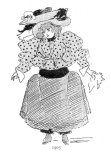 There is a pictorial hiatus of some years, but the text notes that crinoline for women enjoyed a sway of some
years' duration. For, taking the tracings from the plates in the order in which they are given in the book, we find a
subdued form of the article in the female costume for 1905. The ladies may well regard this plate as astounding.
There is even a suggestion of " bloomer " about its nether portion, and if the hat is not without precedent in history,
the waist is little short of revolutionary.
There is a pictorial hiatus of some years, but the text notes that crinoline for women enjoyed a sway of some
years' duration. For, taking the tracings from the plates in the order in which they are given in the book, we find a
subdued form of the article in the female costume for 1905. The ladies may well regard this plate as astounding.
There is even a suggestion of " bloomer " about its nether portion, and if the hat is not without precedent in history,
the waist is little short of revolutionary.
 The next plate displays a gentleman's habit for the year 1908. The tailors, fifteen years hence, seemed to have
borrowed, in the construction of the coat, very liberally from the lady's mantle of 1893. Apropos of this and the
ensuing three plates, it is pleasing to be told, as we are by the author of this book, that the long reign of black is
doomed. Towards the close of April, 1898, Lord Arthur Lawtrey appeared in the Park attired literally in purple and fine linen,
i.e., in a violet coat, with pale heliotrope trousers.
The next plate displays a gentleman's habit for the year 1908. The tailors, fifteen years hence, seemed to have
borrowed, in the construction of the coat, very liberally from the lady's mantle of 1893. Apropos of this and the
ensuing three plates, it is pleasing to be told, as we are by the author of this book, that the long reign of black is
doomed. Towards the close of April, 1898, Lord Arthur Lawtrey appeared in the Park attired literally in purple and fine linen,
i.e., in a violet coat, with pale heliotrope trousers.
 Yet, in spite of the opposition to Lord Arthur, the wave was due, and the affection for colour spread. The new
century, at its birth, saw black relegated to the past -- also to the future. This was midway in the Ebullient Age. Pent
up for decades, mankind naturally began to slop over with sartorial enthusiasm. In 1920 its bizarrerie
became offensive, and an opposition crusade was directed against it. Something had to be conceded. Trousers,
which had been wavering between nautical buttons and gallooned knees -- or, in the vernacular of the period, a sail
three sheets in the wind and a flag at half-mast were the items sacrificed. Knee-breeches enjoyed vogue for a time,
but only for a time; for they vanished suddenly in 1930 and were replaced by tights or shapes. Boots made way for
Elizabethan slippers. Hats had long since gone the way of the superannuated. Taught by the Darwinian theory,
society discovered whence its tendency to baldness originated. They had recourse by degrees to flexible tiles of
extraordinary cut.
Yet, in spite of the opposition to Lord Arthur, the wave was due, and the affection for colour spread. The new
century, at its birth, saw black relegated to the past -- also to the future. This was midway in the Ebullient Age. Pent
up for decades, mankind naturally began to slop over with sartorial enthusiasm. In 1920 its bizarrerie
became offensive, and an opposition crusade was directed against it. Something had to be conceded. Trousers,
which had been wavering between nautical buttons and gallooned knees -- or, in the vernacular of the period, a sail
three sheets in the wind and a flag at half-mast were the items sacrificed. Knee-breeches enjoyed vogue for a time,
but only for a time; for they vanished suddenly in 1930 and were replaced by tights or shapes. Boots made way for
Elizabethan slippers. Hats had long since gone the way of the superannuated. Taught by the Darwinian theory,
society discovered whence its tendency to baldness originated. They had recourse by degrees to flexible tiles of
extraordinary cut.
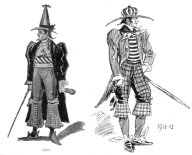
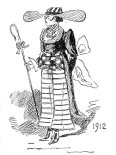 A further glance at the costume for the swells between 1902 and 1912 reveals the existence of an entirely novel
adjunct to the male attire. Silk bows have been worn about the neck for nearly, if not quite, a century, but never in
the body of the attire. It is true the gentleman as early as 1910 adorns his nether garments with a plain silk band,
but in the elderly party of 1911 he has assumed gay ribbons for his shoes as well as at his knees and throat. In this
plate we greet the presence of an unmistakable umbrella as a good omen. But it is only a short-lived rapture, for the
spruce young party in the next sketch is balancing lightly between thumb and forefinger what we take to be nothing
more or less than a shepherd's crook. This is hardly an edifying prospect. Yet if we do not altogether mistake
the two wing-shaped objects projecting from his person, it is not the only feature of gentlemen's fashions twenty
years hence which will occasion a shock. Nor must we overlook the frivolity of the lady of the same period who is
doing her utmost to look pleasant under the most trying conditions. Yet it must be confessed that in spite of its
intricate novelty and perplexity, the costume must still be called plain. One might be forgiven for surmising that the
kerchief-shaped article covering a portion of the lady's bust is formed of riveted steel, for surely nothing else could
support the intolerable load she is so blandly carrying off.
A further glance at the costume for the swells between 1902 and 1912 reveals the existence of an entirely novel
adjunct to the male attire. Silk bows have been worn about the neck for nearly, if not quite, a century, but never in
the body of the attire. It is true the gentleman as early as 1910 adorns his nether garments with a plain silk band,
but in the elderly party of 1911 he has assumed gay ribbons for his shoes as well as at his knees and throat. In this
plate we greet the presence of an unmistakable umbrella as a good omen. But it is only a short-lived rapture, for the
spruce young party in the next sketch is balancing lightly between thumb and forefinger what we take to be nothing
more or less than a shepherd's crook. This is hardly an edifying prospect. Yet if we do not altogether mistake
the two wing-shaped objects projecting from his person, it is not the only feature of gentlemen's fashions twenty
years hence which will occasion a shock. Nor must we overlook the frivolity of the lady of the same period who is
doing her utmost to look pleasant under the most trying conditions. Yet it must be confessed that in spite of its
intricate novelty and perplexity, the costume must still be called plain. One might be forgiven for surmising that the
kerchief-shaped article covering a portion of the lady's bust is formed of riveted steel, for surely nothing else could
support the intolerable load she is so blandly carrying off.
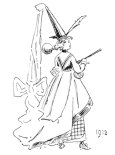 Female costume seems to have always been regulated by the same waves and rules which governed male
costume, but in a different degree. In the Ebullient period it is chiefly distinguished by head-dress and the total
abolition of stays. Crinoline, in spite of certain opposition, enjoyed a slight revival in the present day, and in 1897
the divided skirt threatened to spread universally. But it passed off, and nothing of a radical order was attempted in
this direction until the revo!ution which brought in trousers for women in 1942.
Female costume seems to have always been regulated by the same waves and rules which governed male
costume, but in a different degree. In the Ebullient period it is chiefly distinguished by head-dress and the total
abolition of stays. Crinoline, in spite of certain opposition, enjoyed a slight revival in the present day, and in 1897
the divided skirt threatened to spread universally. But it passed off, and nothing of a radical order was attempted in
this direction until the revo!ution which brought in trousers for women in 1942.
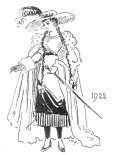 Meantime, in the next plate of a lady's costume, which is dated 1922, we have presented a very rational and
beautiful style of dress. The skirt, it is true, is short enough to alarm prim contemporary dames, and it is scarcely
less assuring to find in the whole of the remaining plates only three periods when it seems to have got longer. But
doubtless the very ample cloak, which is so long that it even trails upon the ground, extenuated and in some degree
justified its shortness.
Meantime, in the next plate of a lady's costume, which is dated 1922, we have presented a very rational and
beautiful style of dress. The skirt, it is true, is short enough to alarm prim contemporary dames, and it is scarcely
less assuring to find in the whole of the remaining plates only three periods when it seems to have got longer. But
doubtless the very ample cloak, which is so long that it even trails upon the ground, extenuated and in some degree
justified its shortness.
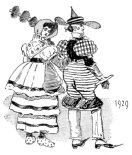
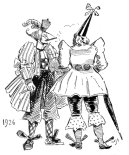
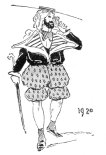

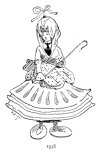
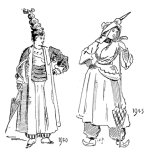
A further detail which might interest the student concerns the revival of lace, which transpired so early as 1905. Curiously enough, this dainty adjunct to the attire had fallen into desuetude among women. More curiously still, it remained for the sterner sex to revive it. For it was in that year that the backbone of stiff white collars and cuffs was broken. A material being sought which would weather the existing atmospheric conditions, it was yielded in lace, which continued in vogue for at least two generations.
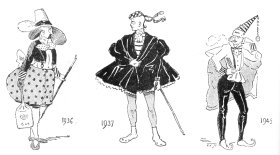 If we look for the greatest donkey in the entire collection, it is obvious that we shall find him in the middle-aged
party of 1936, who is gadding about in inflated trunks and with a fan in his hand. If it were not for the gloves and
polka-dot neck-wear we should assume that this costume was a particularly fantastic bathing-suit. The youth of the ensuing year, in the next plate,
is probably a son of the foregoing personage, for it is not difficult to detect a strong family likeness. As to the
costume itself for 1937, barring the shaved head and Caledonian cap, there is nothing particular to be urged
against it. It seems clearly a revival of the dress of the Middle Ages.
If we look for the greatest donkey in the entire collection, it is obvious that we shall find him in the middle-aged
party of 1936, who is gadding about in inflated trunks and with a fan in his hand. If it were not for the gloves and
polka-dot neck-wear we should assume that this costume was a particularly fantastic bathing-suit. The youth of the ensuing year, in the next plate,
is probably a son of the foregoing personage, for it is not difficult to detect a strong family likeness. As to the
costume itself for 1937, barring the shaved head and Caledonian cap, there is nothing particular to be urged
against it. It seems clearly a revival of the dress of the Middle Ages.
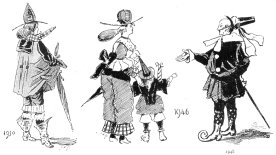 It is at least consoling to feel that only a very small minority of those who read this is destined to enliven our
thoroughfares with such grotesque images as is furnished by the plate for 1945. The confidently asinine
demeanour of this youth is hardly relieved by the absurdity of a watch suspended by a chain from the crown of his
hat. That society protested against this aspect of idiocy is evinced by the harmonious costume for 1950, in which a
complete revolution is to be noted. We hasten to observe that the latter plate -- the one for 1948 -- is that of a
clergyman.
It is at least consoling to feel that only a very small minority of those who read this is destined to enliven our
thoroughfares with such grotesque images as is furnished by the plate for 1945. The confidently asinine
demeanour of this youth is hardly relieved by the absurdity of a watch suspended by a chain from the crown of his
hat. That society protested against this aspect of idiocy is evinced by the harmonious costume for 1950, in which a
complete revolution is to be noted. We hasten to observe that the latter plate -- the one for 1948 -- is that of a
clergyman.
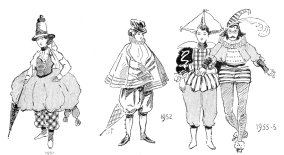 There is very little beauty about the lady's costume for 1946, or in that of the child in the plate. That for 1950 is
a great improvement. The exaggerated chignon has disappeared, and two seasons later we find the costume fascinating to a degree, although certainly partaking more of the male
than of the female order of dress. Without the cape it is not so captivating, as shown by the plate dated 1955-6,
where both a lady and gentleman are shown, although to accord praise to either's hideous style of head-dress
would be to abandon permanently all reputation for taste.
There is very little beauty about the lady's costume for 1946, or in that of the child in the plate. That for 1950 is
a great improvement. The exaggerated chignon has disappeared, and two seasons later we find the costume fascinating to a degree, although certainly partaking more of the male
than of the female order of dress. Without the cape it is not so captivating, as shown by the plate dated 1955-6,
where both a lady and gentleman are shown, although to accord praise to either's hideous style of head-dress
would be to abandon permanently all reputation for taste.
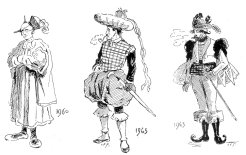 The policeman shown in the drawing for 1960 seems to have a very easy time of it, for no man's person can be
considered in danger from the mob who habitually offers so many points à saisir as this policeman's
head displays. We may likewise suspect the military gentleman depicted in the plate for 1965. It is not customary in
the present day for army officers to affect umbrellas, but seventy years hence it may be found necessary to protect
one's head-dress.
The policeman shown in the drawing for 1960 seems to have a very easy time of it, for no man's person can be
considered in danger from the mob who habitually offers so many points à saisir as this policeman's
head displays. We may likewise suspect the military gentleman depicted in the plate for 1965. It is not customary in
the present day for army officers to affect umbrellas, but seventy years hence it may be found necessary to protect
one's head-dress.
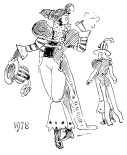


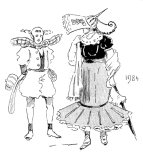 engraving, may well be carrying about his MSS. inside his umbrella. Whatever may be the merits of the spring
fashions for 1978, it would appear to have been universal (to speak of the future in the past tense), for both these
young gallants are dressed precisely alike. Of the three remaining designs, that of 1984 appears to us to exhibit the
contour of the lady's figure most generously, and to have certain agreeable and distinctive traits of its own which
are not only lacking in the gentleman's apparel, but are absent from the inane conception which appears to have
obtained vogue five years later.
engraving, may well be carrying about his MSS. inside his umbrella. Whatever may be the merits of the spring
fashions for 1978, it would appear to have been universal (to speak of the future in the past tense), for both these
young gallants are dressed precisely alike. Of the three remaining designs, that of 1984 appears to us to exhibit the
contour of the lady's figure most generously, and to have certain agreeable and distinctive traits of its own which
are not only lacking in the gentleman's apparel, but are absent from the inane conception which appears to have
obtained vogue five years later.
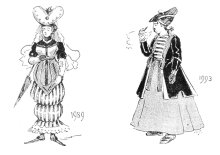 As to the last plate in the series, we can only remark that if the character of our male
posterity after four or five generations is to be as effeminate as its attire, the domination by the fair sex cannot be
many centuries distant. The gentleman appears to be lost in contemplation of a lighted cigar. If he possessed the
gift of seeing himself as others now see him, he would probably transfer his attention to another and not less
contiguous quarter.
As to the last plate in the series, we can only remark that if the character of our male
posterity after four or five generations is to be as effeminate as its attire, the domination by the fair sex cannot be
many centuries distant. The gentleman appears to be lost in contemplation of a lighted cigar. If he possessed the
gift of seeing himself as others now see him, he would probably transfer his attention to another and not less
contiguous quarter.
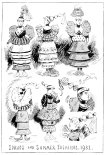 In a general review of the costumes of the forthcoming century the Doctor observes:-
In a general review of the costumes of the forthcoming century the Doctor observes:-
"The seventeenth is famous as the brown; the eighteenth is with us the yellow; and the nineteenth we term the black century. I am asked my opinion of the twentieth. It is motley. It has seen the apotheosis of colour. Yet in worshipping colour we do not confound the order of things. As is the twentieth, so was the fifteenth."
The author furthermore observes that "the single article of apparel which stands out most silhouetted against the background of the last century's dress is its hard shiny, black head-gear. It is without a parallel. It is impossible for us to conceive of a similar article surviving for so long a period; and I venture to say, versed as I am in the science, nothing more absurd and irredeemably inappropriate, or more openly violating in texture and contour every rational idea on the subject, was ever launched. In 1962 the neck was left bare, in the négligé fashion, in imitation of Butts, the aesthete who the year previously had discovered the North Pole. In 1970, however, ruffs were resumed and are still worn, and I regret to say are growing in magnitude, until they threaten to eclipse precedent."
At this juncture the notes and nap together terminated, for our elderly gentleman woke up.